Prevalence of dementia
Key statistics

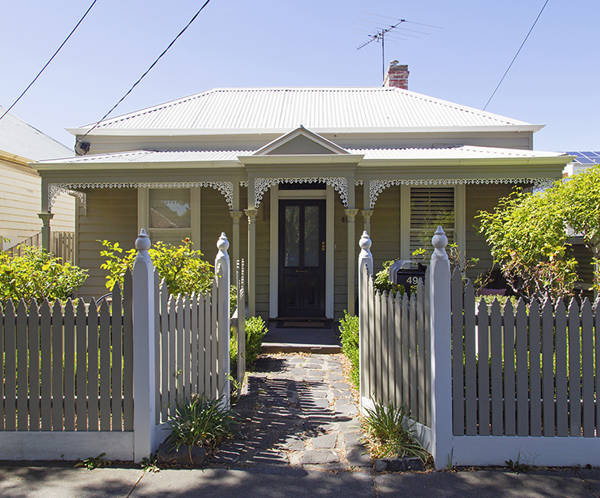


It is estimated that in 2023 there were 411,100 Australians living with dementia. However, the exact number of people with dementia is currently not known as there is no single authoritative data source for deriving dementia prevalence in Australia.
This page presents dementia prevalence, as estimated by the Australian Institute of Health and Welfare (AIHW):
- by sex and age in 2023
- by place of residence in 2022 (that is, living in the community versus living in cared accommodation)
- for each year between 2024 and 2058
- by states/territories, remoteness, socioeconomic and small geographic areas in 2022.
It also presents how the prevalence rate of dementia in Australia compares with other countries.
Expand the headings below for information on the available data sources and methodologies to estimate dementia prevalence. Refer to the Prevalence data tables for the underlying data presented in this page.
See Population health impacts of dementia among First Nations people and Dementia among people from culturally and linguistically diverse backgrounds for more information on the challenges involved in estimating dementia prevalence among these groups.
Australia’s dementia statistics are derived from a variety of data sources of varying quality, including administrative data (such as data on medications dispensed, hospital visits, aged care services, and causes of death), survey data (such as the Australian Bureau of Statistics (ABS) Survey of Disability, Ageing and Carers (SDAC)) and epidemiological studies (both Australian and international). As each data source has incomplete coverage of people with dementia, major studies have used a number of different approaches to estimate the prevalence of dementia in Australia. For example:
- The Economic cost of dementia report by the National Centre for Social and Economic Modelling estimated dementia prevalence using a pooled data set of Australian longitudinal studies for people aged 65 and over, which included cases of ‘probable dementia’ and mild cognitive impairment (Anstey et al. 2010; Brown et al. 2017). This resulted in an estimated 413,000 people living with dementia in Australia in 2017, higher than what was estimated by AIHW for the same year.
- The 2019 Global Burden of Disease Study estimated dementia prevalence through a systematic review of surveys and epidemiology studies, as well as administrative data. An updated literature review for the period 2016–2017 found 38 new studies were in scope for calculating prevalence of dementia at the global, regional, and country level (GBD 2019). This resulted in an estimated 301,000 people living with dementia in Australia in 2017, lower than what was estimated by AIHW for the same year.
Given the wide range of dementia prevalence estimates reported, improvements in dementia data are needed to truly understand the number of people with dementia in Australia.
Taking into consideration the strengths and limitations of available data sources and methodologies, the AIHW has produced revised dementia prevalence estimates for Australia. Our approach in this report is based on the methodology used in the AIHW 2012 Dementia in Australia report to estimate prevalence but has incorporated new data. The prevalence of dementia among Australians aged 60 and over was estimated using data from a systematic review of worldwide dementia prevalence conducted by Alzheimer’s Disease International for the World Alzheimer report 2015 (ADI 2015). Prevalence estimates for those aged under 60 were derived from a recent Australian study (Withall et al. 2014). Therefore, the dementia prevalence estimates presented in this report supersede those published by AIHW in the 2012 Dementia in Australia report. See Methods for more details on the methodology used to calculate dementia prevalence estimates.
There are ongoing efforts to improve the accuracy of dementia prevalence estimates in Australia. As a result, the approach used to estimate the prevalence of dementia in this report will likely be superseded in coming years as findings from these initiatives become available. See 3: Dementia prevalence and incidence of the National Dementia Data Improvement Plan 2023–2024 for information on current developments and future activities aimed at improving dementia prevalence data.
How many people have dementia in Australia?
The AIHW estimates that in 2023 there were around 411,100 people living with dementia in Australia, including nearly 257,500 women and 153,700 men. This is equivalent to 15 people with dementia per 1,000 Australians (19 per 1,000 women and 12 per 1,000 men).
New health condition question in the 2021 Census
In the 2021 Census, a new long term health condition question was asked, which captured whether a person had one or more of a select group of health conditions. One of these select conditions was dementia (including Alzheimer’s).
For the purposes of the census, long-term conditions are conditions that:
- the respondent has been told they have by a doctor or nurse
- have lasted, or are expected to last, for 6 months or more
- may recur from time to time
- are controlled by medication, or
- are in remission (ABS 2022).
The first results of the census were released on 28 June 2022, and they showed that 189,162 people living in Australia self-reported a dementia diagnosis (78,154 males and 111,003 females). While the ABS advises that their health surveys (the National Health Survey and the National Aboriginal and Torres Strait Islander Health Survey) continue to capture the prevalence of these conditions more accurately, work has commenced to better understand how the new census estimate aligns with other dementia diagnosis information, as well as how these data can be used to improve how we understand and monitor dementia prevalence in Australia.
The rate of dementia rises quickly with age – from less than one person with dementia per 1,000 Australians aged under 60, to 71 per 1,000 Australians aged 75–79, and then to 429 per 1,000 Australians aged 90 and over. Interestingly, the rates are similar for men and women in the younger age groups, but quickly diverge with increasing age. For the oldest age group, the rate of dementia among women is 1.4 times the rate of men (479 per 1,000 women and 337 per 1,000 men) (Figure 2.1).
Figure 2.1: Prevalence of dementia in 2023: estimated number and rate, by age and sex
Bar chart shows that the number of people with dementia and the rate of dementia both increase with age. The rate of dementia is higher in women than men in each age group, with the difference greatest among those aged 90 and over.
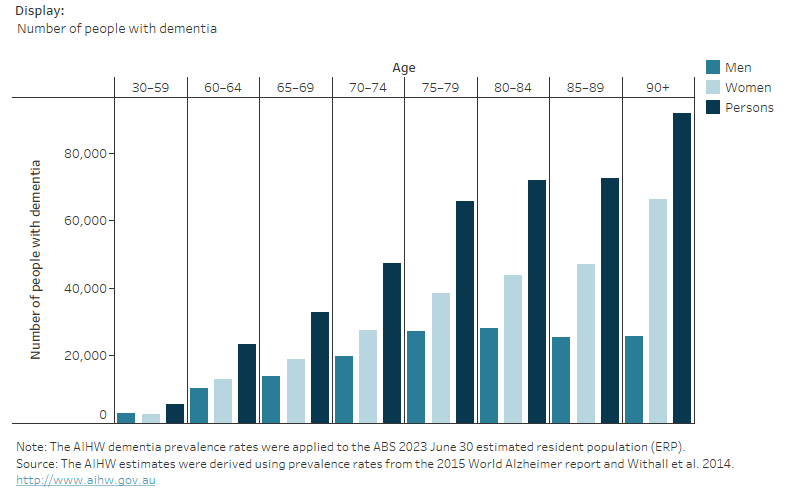
67% of people with dementia live in the community
Based on AIHW estimates, there were an estimated 267,700 people with dementia living in the community (as opposed to cared accommodation) in 2022 (102,200 men and 165,500 women). This equates to 67% of all people with dementia living in the community (68% of men and 66% of women with dementia) (Figure 2.2).
As people with dementia age, they are more likely to move into residential aged care homes and so the proportion living in the community decreases with increasing age. The majority of people with younger onset dementia (aged less than 65) were living in the community (95% or 26,900 people). Among the older age groups, just over half of people with dementia lived in the community (52% of people with dementia aged 85–89 or 36,400 people and 54% aged 90 and over, or 49,300 people). This decrease was more substantial among women than men.
Figure 2.2: Australians living with dementia in 2022: estimated percentage by age, sex and place of residence
Stacked bar graph shows that younger people with dementia are more likely to live in the community, while older people with dementia are more likely to live in cared accommodation.
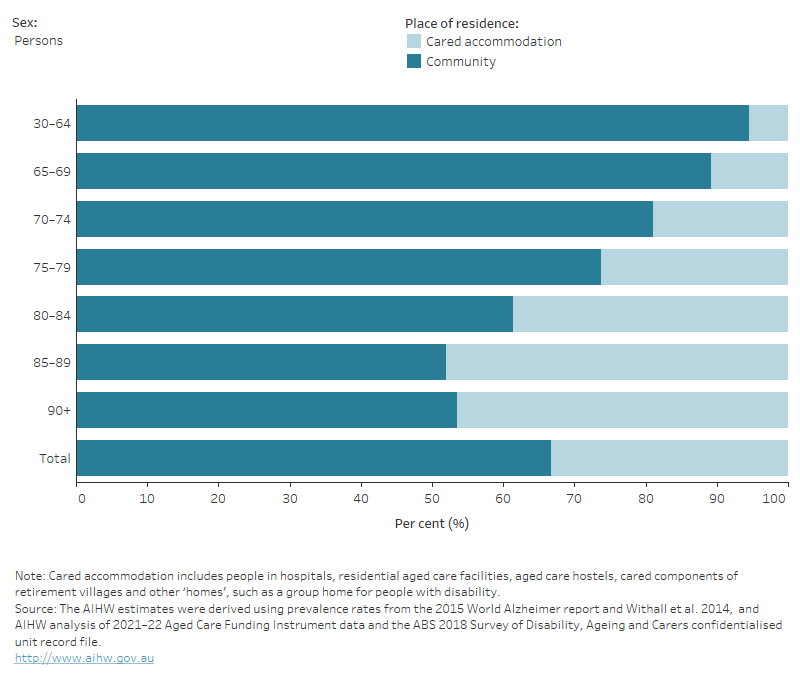
It is often assumed that people with dementia require care at all times. However, with the appropriate help and support, people with dementia can live independently in their own home, often until their dementia has advanced and care needs become greater.
According to the Survey of Disability, Ageing and Carers (SDAC), of the people with dementia who lived in the community in 2018, 86% lived in private dwellings with other people, while 14% lived alone. Men were more likely to have been living with other people (91%) than women (81%) (Table S2.3). Further information on the SDAC can be found in the Technical notes.
The number of Australians with dementia is projected to more than double by the year 2058
With Australia’s population expected to continue growing and ageing into the future, the number of people with dementia is also expected to rise. Applying the AIHW-derived prevalence rates discussed above to ABS population projections for each year to 2058, it is estimated the number of people with dementia in Australia will more than double over this period – from just over 411,100 in 2023 to 849,300 in 2058 (around 315,500 men and 533,800 women) (Figure 2.3).
This trend is driven by the projected continued growth and ageing of Australia’s population, as the condition is increasingly common in older age. As demographic projections over long periods carry a large degree of uncertainty and this approach assumes that the incidence of dementia (that is, no changes in the rate of new dementia cases in future years) and mortality rates for dementia remain the same, these estimates should be interpreted with caution. In particular, recent findings suggest that the official estimated resident population for Australia is less accurate as age increases, especially among those aged 100 and over (Wilson and Temple 2020). Refer to table S2.4 for more details on the estimated dementia prevalence by age and sex between 2010 and 2058.
Figure 2.3: Australians living with dementia between 2024 and 2058: estimated number by sex and year
Line graph showing that the estimated number of people with dementia in Australia is expected to increase in the future, due to the projected continued growth and ageing of Australia’s population.
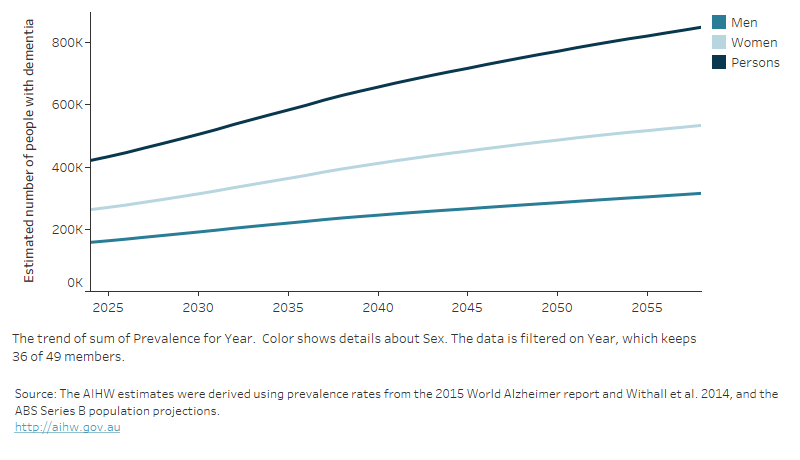
How does dementia prevalence vary by geographic and socioeconomic areas?
Given the lack of suitable data to accurately estimate dementia prevalence at the national level, it isn’t surprising that estimating dementia prevalence at a finer disaggregation is even more difficult. However, the derived age-specific and sex-specific national prevalence rates can be used to illustrate the impact of different age structures and population sizes on how the number of people with dementia varies across Australia. Dementia prevalence has been estimated by applying these rates to state/ territory, remoteness, socioeconomic area, primary health network (PHN) and Statistical Area Level 2 (SA2) populations.
Figure 2.4: Australians living with dementia in 2022: estimated number by sex, and geographic or socioeconomic area
Bar graph showing the numbers of men and women with dementia were highest in the ost populous states, New South Wales, Victoria and Queensland, and in Major cities, but were spread evenly across socioeconomic areas. The number of women with dementia is higher than men across all areas shown.
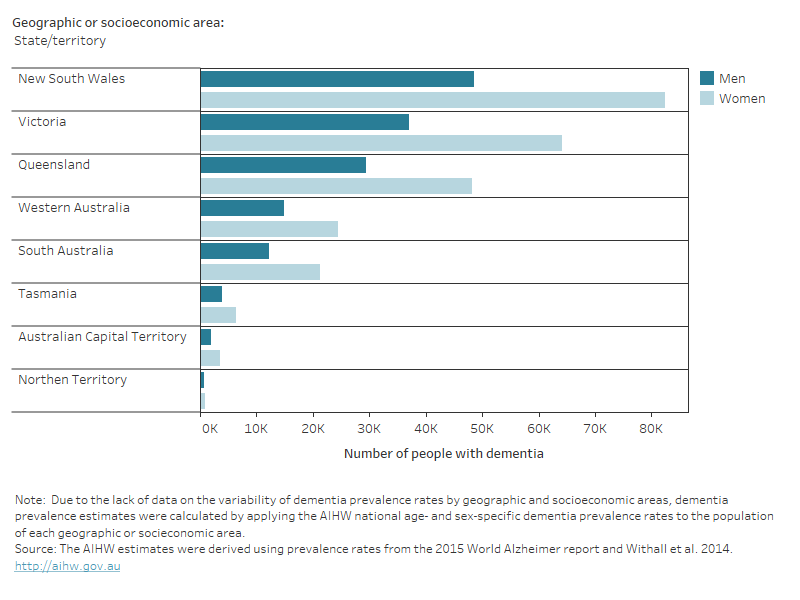
A report using nationwide clinical data from 569 general practices found that dementia was similarly present across socioeconomic and remoteness areas in Australia (NPS MedicineWise 2020). These data provide important insights on those people in the community with diagnosed dementia who attend a regular general practice.
Figure 2.5 shows the estimated number of people with dementia by sex and PHN. There are 31 PHNs across Australia which closely align with the state and territory local hospital networks. The PHN with the highest estimated number of people with dementia is Eastern Melbourne (over 25,600 people), while the lowest is Western Queensland (723 people). Due to the way these prevalence estimates are calculated, PHNs with larger, older populations will have a larger number of estimated people with dementia.
Prevalence estimates by statistical area 2 (SA2) are available in supplementary data table S2.9.
Figure 2.5: Australians living with dementia in 2022: estimated number by sex and primary health network (PHN)
This visualisation includes a map of Australia and shows that Eastern Melbourne had the highest number of estimated dementia prevalence while Western Queensland had the lowest.
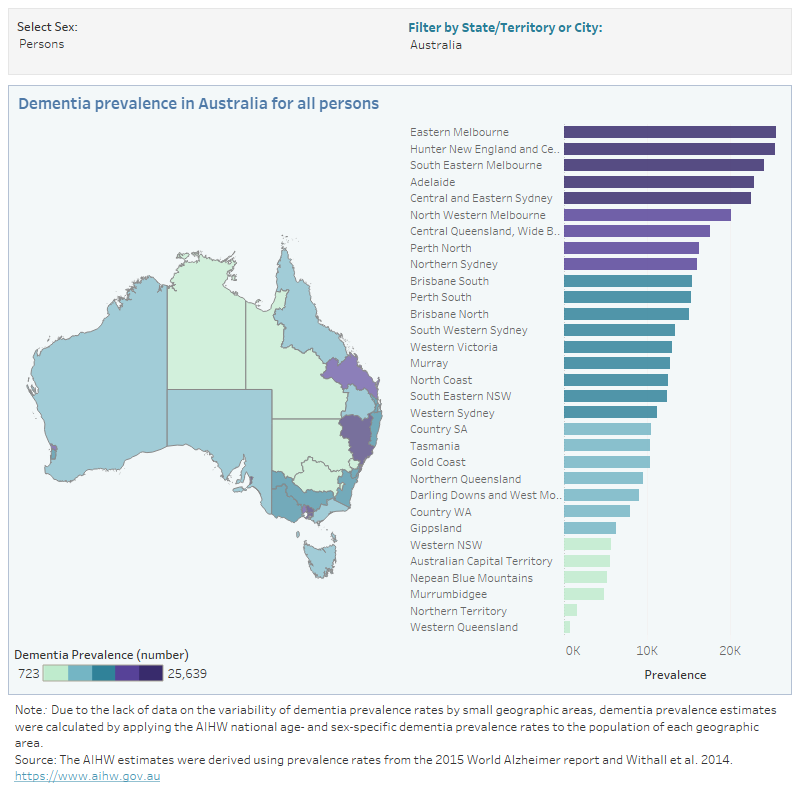
International comparisons of dementia prevalence
International comparisons of dementia prevalence statistics are a useful starting point for learning how other nations with similar population profiles are experiencing dementia. The Organisation for Economic Co-operation and Development (OECD) publishes dementia prevalence rate estimates for OECD countries that provide a useful comparison for Australia as most are considered developed, high-income countries. The 2021 OECD dementia prevalence rates were slightly lower to the estimates presented in this report, but used a different methodology and data source. The OECD rates were based on the regional prevalence rates published in the Institute for Health Metrics and Evaluation (IHME) Global Burden of Disease (GBD) study 2019 and were subject to varying quality of information across regions, so they should only be used for international comparisons.
The OECD estimated that the prevalence of dementia in Australia was 13.2 cases per 1,000 population in 2021, slightly less than the OECD average of 15.0 per 1,000 population and ranking 12th lowest out of 38 countries (Figure 2.6). Mexico had the lowest rate, just over one third of the Australian rate at 4.5 per 1,000 population, whereas Japan’s rate was highest at 32.2 per 1,000 population (OECD 2023). These are unadjusted prevalence rates, meaning that much of the variation in dementia prevalence across countries is due to differences in population age structures, with ageing OECD nations tending to have higher prevalence rates.
Figure 2.6: People living with dementia in Organisation for Economic Co-operation and Development (OECD) member countries in 2021: estimated rate by country
Bar graph showing that the estimated rate of dementia in Australia was slightly lower than the average rate for OECD countries.
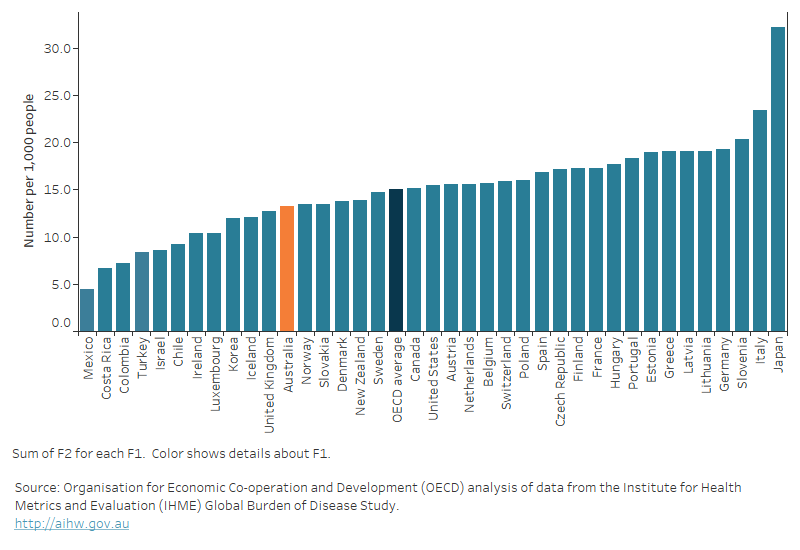
ABS (Australian Bureau of Statistics) (2022) Health: census, ABS, Australian Government, accessed 1 July 2022.
ADI (Alzheimer’s Disease International) (2015) World Alzheimer report 2015: the global impact of dementia: an analysis of prevalence, incidence, cost and trends, Alzheimer's Disease International, accessed 17 August 2022.
Anstey KJ, Burns RA, Birrell CL, Steel D, Kiely KM and Luszcz MA (2010) 'Estimates of probable dementia prevalence from population-based surveys compared with dementia prevalence estimates based on meta-analyses', BMC Neurology, 10(1):62, doi:10.1186/1471-2377-10-62.
AIHW (Australian Institute of Health and Welfare) (2012) Dementia in Australia, AIHW, Australian Government, accessed 17 August 2022.
Brown L, Hansnata E and La HA (2017) Economic cost of dementia in Australia 2016–2056, University of Canberra, accessed 17 August 2022.
GBD (Global Burden of Disease) 2019 Diseases and Injuries Collaborators (2019) 'Global burden of 369 diseases and injuries in 204 countries and territories, 1990–2019: a systematic analysis for the Global Burden of Disease Study 2019', The Lancet, 396:1204–1222, doi:10.1016/S0140-6736(20)30925-9.
IHME (Institute for Health and Metrics and Evaluation) (2020) GBD Results [data set], healthdata.org, accessed 16 January 2024.
NPS MedicineWise (2020) General Practice Insights report July 2018 – June 2019, NPS MedicineWise, accessed 17 August 2022.
OECD (Organisation for Economic Co-operation and Development) (2023) 'Health at a Glance 2023: OECD indicators', 2023 edn, OECD Publishing, doi:10.1787/19991312.
Wilson T and Temple J (2020) 'The rapid growth of Australia’s advanced age population'. Journal of Population Research, 37:377–389, doi:10.1007/s12546-020-09249-7.
Withall A, Draper B, Seeher K and Brodaty H (2014) 'The prevalence and causes of younger onset dementia in Eastern Sydney, Australia', International Psychogeriatrics, 26(12):1955–1965, doi:10.1017/S1041610214001835.


